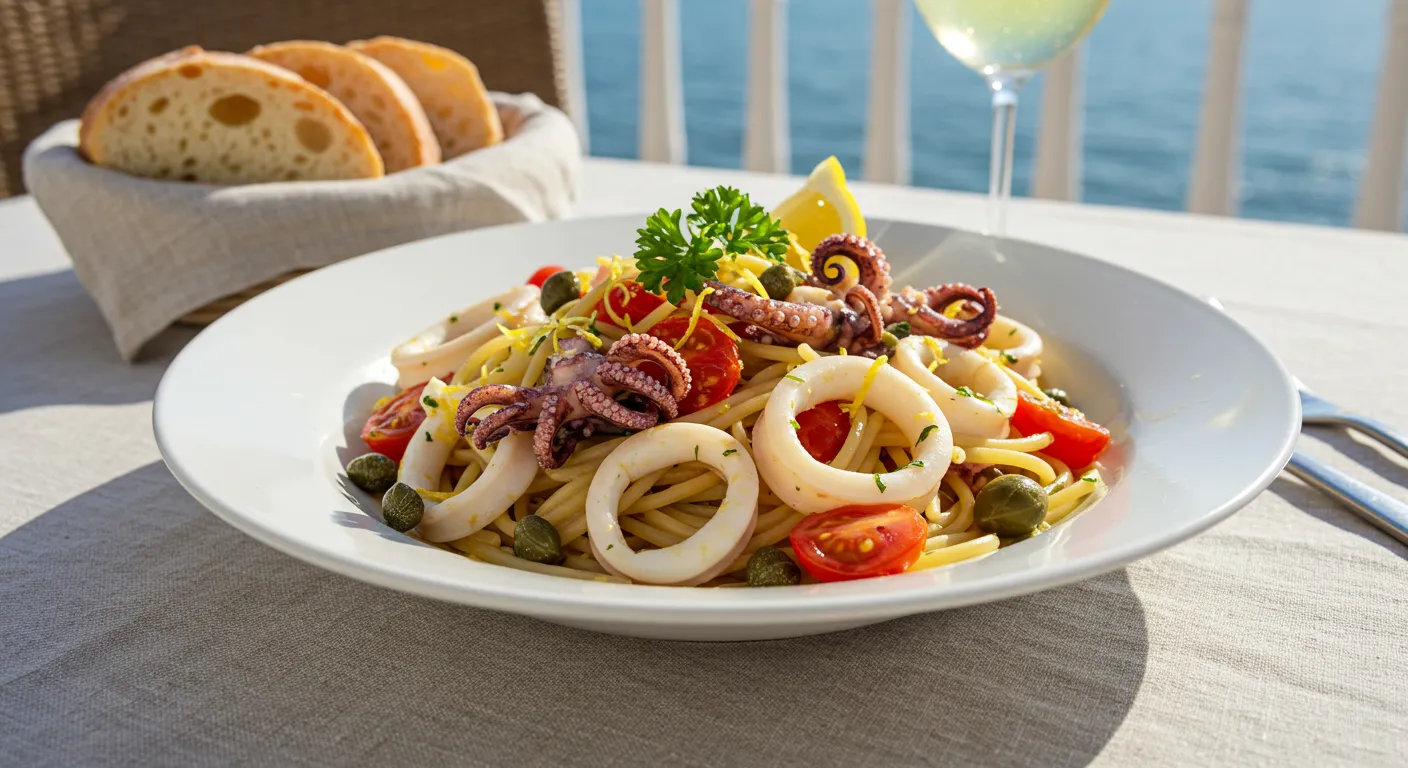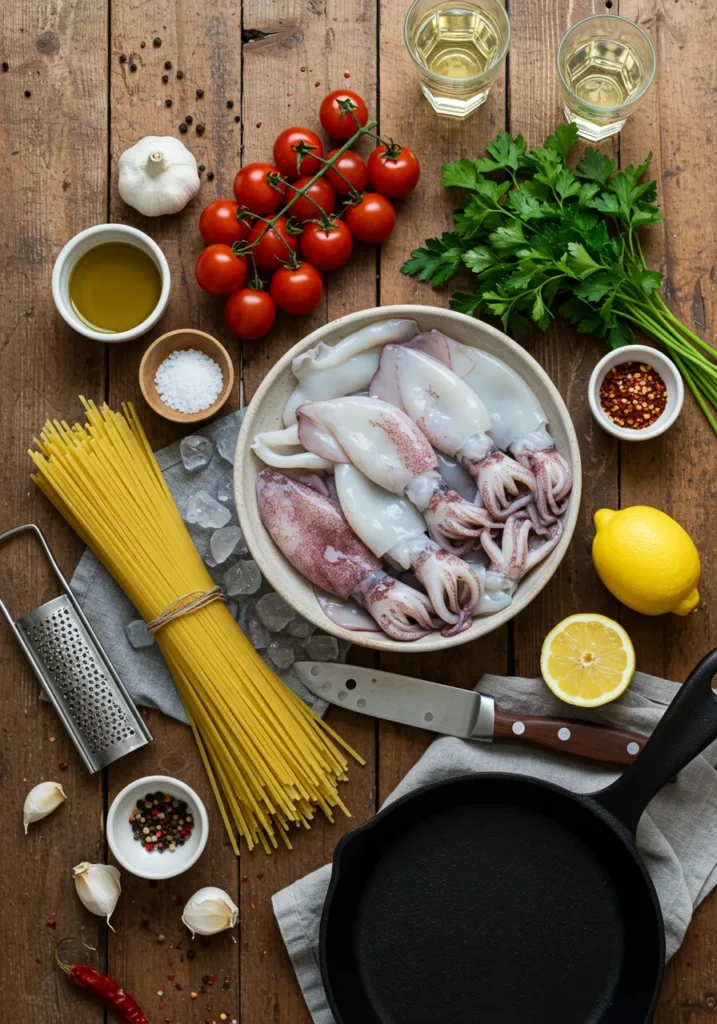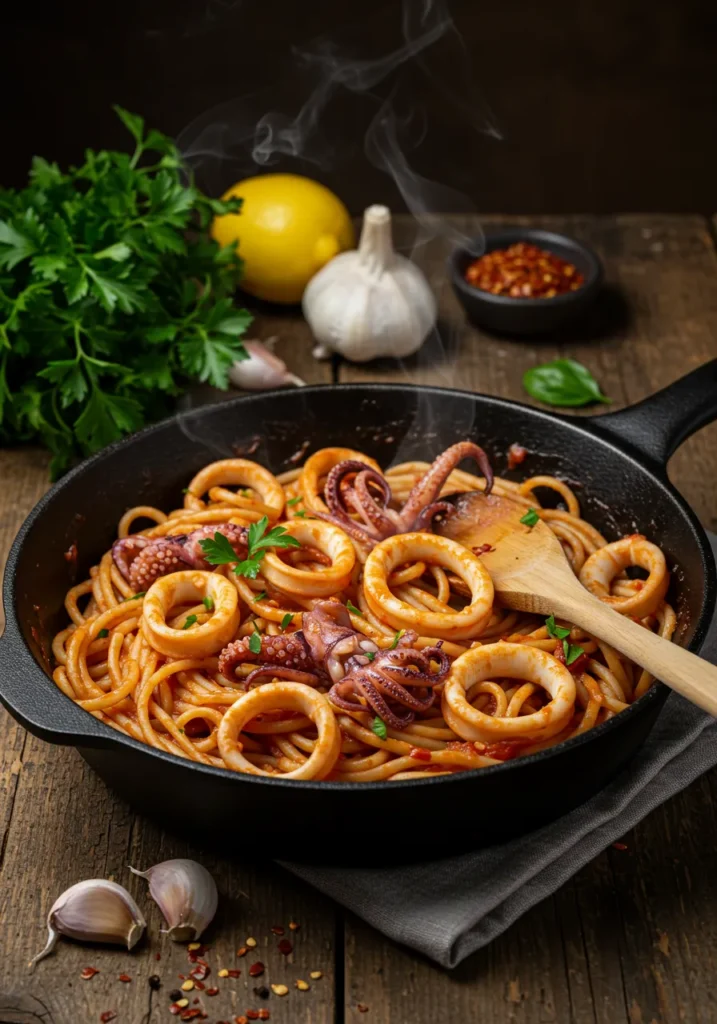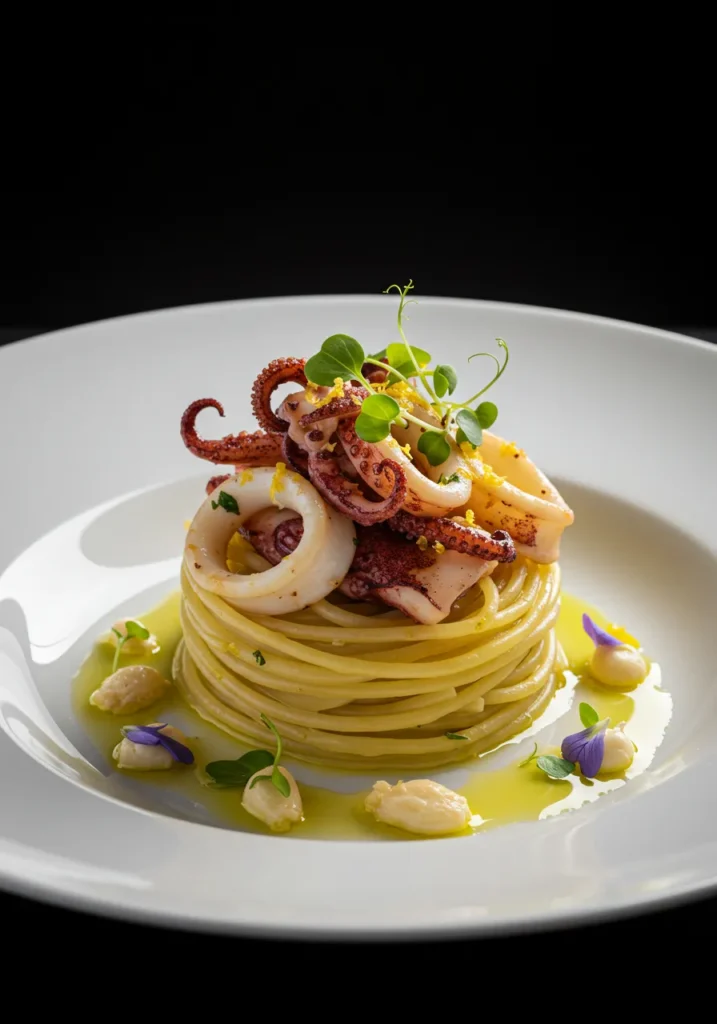Best Calamari Pasta – Easy Italian Seafood Dinner

If you’re craving a flavorful, seafood-rich meal that’s both elegant and easy to prepare, look no further than calamari pasta. This Italian-inspired dish brings together tender calamari rings, a rich tomato basil sauce, and perfectly cooked pasta to create a comforting yet sophisticated dinner that’s sure to impress. Whether you’re a fan of classic coastal cuisine or just looking for something new to spice up your weeknight dinners, this recipe delivers bold flavors with minimal effort.
Seafood and pasta are a timeless match, and when calamari joins the mix, it elevates the dish with its delicate texture and mild, slightly sweet flavor. This isn’t just your average pasta and calamari combo—it’s a full-on flavor celebration that highlights fresh ingredients and traditional Italian techniques.
In this article, you’ll discover everything you need to make the best calamari and pasta dinner at home. From choosing the right type of squid to perfecting the tomato basil sauce, we’ll guide you through each step with helpful tips, substitution ideas, and serving suggestions. Let’s dive into the world of squid pasta and create a seafood masterpiece that’s as easy as it is delicious.
Table of Contents
Why You’ll Love This Calamari Pasta Recipe
There’s something truly special about a dish that feels like a fine Italian restaurant meal but is simple enough to whip up in your own kitchen. That’s exactly what this calamari pasta recipe delivers. It’s a beautifully balanced combination of fresh herbs, savory tomatoes, and tender squid—all tossed with perfectly cooked pasta for a dish that hits all the right notes.
You’ll also love how versatile this pasta and calamari recipe is. It works wonderfully for a cozy weeknight dinner but also shines as the centerpiece for a special gathering or date night. It’s fast, too—most of the prep can be done in under 30 minutes, which makes this recipe a go-to even on busy evenings.
Whether you’re a seasoned seafood lover or new to cooking with squid, this recipe makes it easy to master. With just a few fresh ingredients and some smart cooking tips, you’ll be making calamari and pasta like a pro. And the best part? It tastes even better than takeout—without the fuss or the cost.
This is more than just squid pasta—it’s a celebration of simple, clean, and bold Italian flavors in every bite.
Quick Recipe Card
Prep Time: 10 minutes
Cook Time: 20 minutes
Total Time: 30 minutes
Difficulty Level: Easy
Servings: 4
Nutritional Information (per serving)
- Calories: 380
- Protein: 28g
- Carbs: 45g
- Fat: 14g
- Fiber: 4g
- Sodium: 850mg
Equipment Needed
- Large pot for pasta
- Skillet or sauté pan
- Knife and cutting board
- Colander for draining pasta
Ingredients

For the pasta and sauce:
- 12 oz (340g) spaghetti or linguine (or your preferred pasta)
- 1 lb (450g) calamari (sliced into rings, tentacles optional)
- 3 tablespoons (45ml) extra virgin olive oil
- 4 garlic cloves (minced)
- 1 can (14 oz / 400g) crushed tomatoes
- 1/4 teaspoon red pepper flakes (optional)
- 1/2 cup (50g) fresh basil (torn into pieces)
- Salt and pepper, to taste
- 1/2 teaspoon lemon zest (optional, for garnish)
For serving:
- Fresh basil leaves (optional, for garnish)
- Crusty bread (optional)
Making a restaurant-quality calamari pasta at home starts with choosing the right ingredients. This dish shines because of its simplicity, so using fresh, high-quality items wherever possible really makes a difference. Below is everything you’ll need to create a stunning squid pasta that’s full of flavor and ready in under an hour.
How to Make Calamari Pasta – Step-by-Step
Bringing this calamari pasta recipe to life is easier than you might think. With just a few simple steps, you’ll have a flavorful Italian seafood dish on the table in under an hour. The key is to prep everything in advance and follow the cooking times closely—especially when working with squid. Let’s break it down:
Step 1: Prepare the Calamari
If you’re starting with whole squid, clean them thoroughly by removing the head, innards, cartilage, and skin. Slice the bodies into rings about 1/2-inch thick. Tentacles can also be used—just give them a quick rinse and pat dry. If you’re using pre-cleaned frozen calamari, thaw it completely and drain any excess liquid before cooking.
🔪 Pro Tip: Patting the calamari dry with a paper towel helps them sear better and avoids steaming.
Step 2: Cook the Pasta
Bring a large pot of salted water to a boil. Add your pasta—spaghetti, linguine, or fettuccine—and cook until just shy of al dente. Drain and reserve about 1/2 cup of the starchy pasta water to help emulsify the sauce later.
🍝 This step ensures your pasta and calamari finish cooking together in the sauce for maximum flavor.
Step 3: Make the Tomato Basil Sauce
In a large skillet or sauté pan, heat 3 tablespoons of olive oil over medium heat. Add minced garlic and sauté for 1–2 minutes until fragrant but not browned. Add red pepper flakes if using. Pour in crushed tomatoes and stir in a pinch of salt and pepper. Simmer for 10–12 minutes, allowing the sauce to thicken slightly.
Add a splash of white wine, if desired, and continue to simmer for 2–3 more minutes. Stir in torn basil leaves toward the end for a fresh herbal note.
Step 4: Add the Calamari
Add the prepared calamari to the simmering sauce. Cook for just 2–3 minutes—any longer and the squid may turn rubbery. You’ll know they’re done when they turn opaque and curl slightly.
🐙 Timing is crucial here. Squid needs to be cooked either very briefly or for a long stew to stay tender. We’re going with the quick method.
Step 5: Combine Everything
Add the drained pasta to the skillet with the sauce and toss gently to coat. If the sauce is too thick, add a splash of the reserved pasta water to loosen it up. Let everything cook together for 1–2 more minutes so the flavors meld and the pasta finishes cooking.
Step 6: Serve and Garnish
Plate the squid pasta immediately. Top with fresh basil, a drizzle of olive oil, and lemon zest if you like. Serve with crusty bread or a crisp green salad.
Tips for Cooking Calamari Perfectly
One of the most important parts of this calamari pasta recipe is getting the squid just right. Calamari can go from tender to rubbery in a matter of seconds if not cooked properly, but don’t worry—these tried-and-true tips will help you master it every time.

1. Quick or Slow – No In Between
When it comes to cooking squid, the golden rule is: either cook it very quickly (2–3 minutes) or very slowly (30+ minutes). Anything in between will cause the proteins to toughen, giving you chewy calamari. For this pasta and calamari recipe, we’re using the fast method to keep it tender and juicy.
2. Don’t Crowd the Pan
If you’re cooking a large batch of calamari, do it in batches. Overcrowding the pan can lead to steaming instead of searing, which may result in a rubbery texture. Use a wide skillet and make sure the heat is high enough.
3. Prep Matters
Whether using fresh or frozen squid, make sure it’s well cleaned and patted dry before cooking. Excess moisture prevents caramelization and can dilute the flavor of your tomato basil sauce.
4. Slice Evenly
Cut the calamari into uniform rings (about 1/2-inch thick) to ensure even cooking. Tentacles can be left whole or chopped slightly smaller if they’re large.
5. Add at the Right Time
Avoid tossing the calamari into the sauce too early. Add it just before the pasta goes in, and cook only until the squid turns opaque and firm. Overcooking at this stage is the most common mistake in calamari and pasta dishes.
6. Season Lightly
Since calamari has a naturally briny flavor, it doesn’t need much seasoning. A pinch of salt, some fresh cracked pepper, and a squeeze of lemon are usually all it takes.
Serving Suggestions
This flavorful calamari pasta is satisfying on its own, but you can elevate your meal with a few delicious sides and presentation tips. Whether you’re serving it as a casual dinner or a more elegant seafood centerpiece, these ideas will round out your plate beautifully.
1. Salad on the Side
Balance out the richness of the sauce with a simple salad. A lemony arugula salad or a mixed greens salad with shaved fennel adds a fresh, peppery crunch that contrasts beautifully with the pasta and seafood.
2. Bread for Dipping
Don’t let that tomato basil sauce go to waste! Serve this pasta and calamari dish with crusty Italian bread or garlic focaccia to soak up every drop. A piece of toasted sourdough brushed with olive oil also makes a great match.
3. Garnishing for Flavor and Looks
Top your calamari and pasta with:
- Fresh basil leaves
- A drizzle of good-quality extra virgin olive oil
- A sprinkle of lemon zest
- Optional: grated Parmigiano-Reggiano (if you don’t mind breaking the seafood-no-cheese tradition)
These little touches not only enhance the flavor but also make your plate look straight out of a restaurant kitchen.
4. Make it a Multi-Course Italian Meal
If you want to go all out, start with a small antipasto platter (olives, marinated artichokes, cured meats), follow with this stunning squid pasta, and finish with a light dessert like panna cotta or lemon sorbet.
Variations and Substitutions
One of the best things about this calamari pasta recipe is how adaptable it is. Whether you’re working with dietary restrictions, different pantry ingredients, or just want to try something new, there are plenty of ways to customize this dish without sacrificing flavor. Here are some tasty twists to consider:

1. Add a Spicy Kick
Want to turn up the heat? Add a generous pinch of red pepper flakes or a chopped fresh chili when sautéing the garlic. The heat plays beautifully against the sweetness of the tomatoes and the tender calamari, giving your pasta and calamari a bold, fiery edge.
2. Make It Creamy
For a richer version, stir in a splash of heavy cream or a spoonful of mascarpone right before adding the calamari. This creates a velvety tomato-cream sauce that clings to the pasta and gives your calamari and pasta an indulgent twist.
3. Try Different Pasta Shapes
While long noodles like spaghetti or linguine are classic, don’t be afraid to experiment with shapes like rigatoni, penne, or even orecchiette. Short pasta holds sauce differently and can create a heartier, more rustic feel.
🍝 This variation also helps the sauce cling better to each bite—especially useful if you’re making squid pasta with a chunkier tomato sauce.
4. Add More Seafood
Make your pasta and squid a true seafood medley by adding shrimp, clams, or mussels. Just adjust cooking times accordingly—shrimp can go in with the calamari, while clams and mussels should be steamed separately and added at the end.
5. Go Gluten-Free
Swap out traditional pasta for a gluten-free version. Brown rice pasta, chickpea pasta, or even lentil-based noodles work well. Just cook according to package instructions and mix with the sauce as usual.
6. Low-Carb Options
For a lighter version, substitute spiralized zucchini (zoodles) or shirataki noodles. These options soak up the sauce while keeping carbs low and freshness high.
7. Herb and Flavor Variations
- Try parsley or oregano in place of or alongside basil.
- Add capers or olives for a briny, Mediterranean touch.
- A splash of fish sauce or anchovy paste can boost the umami without adding fishiness.
Storage and Reheating Tips
If you happen to have leftovers of this calamari pasta, don’t worry! While seafood dishes are best enjoyed fresh, there are a few tricks to help you store and reheat your meal without sacrificing too much quality. Here’s how to keep it tasty for later:
Storing Leftovers
- Cool Down Quickly: Allow the pasta to cool completely at room temperature before refrigerating it. This helps prevent sogginess and keeps your calamari tender.
- Airtight Container: Store the calamari and pasta in an airtight container to maintain freshness. It should last in the fridge for up to 2 days.
- Keep Sauce and Pasta Separate: If possible, store the sauce and pasta separately to prevent the noodles from absorbing too much liquid, which can cause them to become mushy when reheated.
Reheating Leftovers
- Stovetop Method: Reheat the pasta and sauce in a skillet over medium-low heat. Add a splash of water or extra olive oil to loosen up the sauce and prevent it from drying out. Stir occasionally to ensure the calamari doesn’t overcook.
- Microwave Method: If you’re in a hurry, you can use the microwave. Just be sure to heat the calamari pasta in short intervals (about 30 seconds), stirring in between. Cover the dish with a microwave-safe lid to retain moisture.
🔥 Pro Tip: It’s best to avoid reheating more than once, as repeated heating can affect the texture of the squid.
Freezing
While it’s not ideal to freeze seafood pasta due to the delicate texture of the calamari, you can freeze the sauce separately. Let the sauce cool completely, then store it in an airtight container or freezer bag for up to 1–2 months. When you’re ready to eat, thaw the sauce overnight in the fridge and cook fresh pasta to serve with it.
Frequently Asked Questions (FAQ)
To help you perfect your calamari pasta and answer any lingering questions, we’ve put together some of the most common queries from home cooks. Let’s dive in!
1. Can I use frozen calamari for this recipe?
Absolutely! Frozen calamari is a convenient and affordable option, and it works just as well as fresh when cooked properly. Just be sure to thaw it completely and pat it dry before adding it to your sauce. This will help ensure it sears instead of steaming.
2. How do I know when the calamari is cooked?
The key is to cook the calamari quickly. It will turn opaque and curl slightly when it’s done—this takes only 2–3 minutes in the sauce. Overcooking it will make it tough and rubbery, so keep a close eye on it!
3. Can I make this recipe ahead of time?
While this dish is best enjoyed fresh, you can make the sauce in advance and store it in the fridge for up to 2 days. Just cook the calamari and pasta when you’re ready to serve. This saves time and allows the flavors to meld together before you add the seafood.
4. What can I substitute for basil?
If you don’t have fresh basil, you can use other fresh herbs like parsley, oregano, or thyme. Basil, however, provides a distinct flavor, so if you’re using a substitute, you may want to adjust the seasoning to taste.
5. Is it okay to use a different type of pasta?
Yes! While spaghetti, linguine, and fettuccine are popular choices, you can absolutely use other pasta shapes like penne, rigatoni, or even gluten-free options. Just make sure the pasta you choose can hold up to the sauce and calamari.
6. Can I add other seafood to this dish?
Definitely! This recipe works beautifully with shrimp, mussels, clams, or even scallops. Just adjust the cooking times based on the seafood you add—shrimp, for instance, cooks very quickly, while mussels and clams should be added after the calamari.
7. How can I make this dish spicier?
If you enjoy heat, adding red pepper flakes or a diced fresh chili to the garlic while sautéing will give the dish a spicy kick. You can adjust the amount depending on your preference for spice.
Conclusion
This calamari pasta recipe is a perfect blend of simplicity and sophistication, making it the ideal dish for both everyday meals and special occasions. The tender squid, aromatic basil, and rich tomato sauce come together in a harmonious celebration of Italian flavors. Whether you’re a seafood enthusiast or a pasta lover, this dish has something to offer everyone.
With a few easy-to-follow steps, you can create a restaurant-quality meal right in your own kitchen. From selecting the freshest calamari to choosing the right pasta shape, every detail plays a part in making this dish shine. Don’t forget to add your personal touch with the variations and seasonings that suit your taste!
So, next time you’re craving a hearty yet light seafood dinner, give this squid pasta a try. We guarantee it will become a new favorite in your recipe collection.
